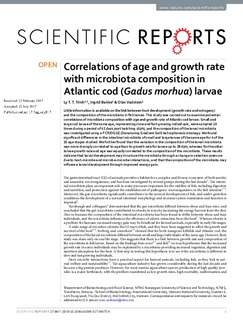| dc.contributor.author | Trinh, Ly T. T. | |
| dc.contributor.author | Bakke, Ingrid | |
| dc.contributor.author | Vadstein, Olav | |
| dc.date.accessioned | 2017-10-26T11:15:49Z | |
| dc.date.available | 2017-10-26T11:15:49Z | |
| dc.date.created | 2017-08-21T18:31:38Z | |
| dc.date.issued | 2017 | |
| dc.identifier.citation | Scientific Reports. 2017, 7 . | nb_NO |
| dc.identifier.issn | 2045-2322 | |
| dc.identifier.uri | http://hdl.handle.net/11250/2462351 | |
| dc.description.abstract | Little information is available on the link between host development (growth rate and ontogeny) and the composition of the microbiota in fish larvae. This study was carried out to examine potential correlations of microbiota composition with age and growth rate of Atlantic cod larvae. Small and large cod larvae of the same age, representing slow and fast growing individuals, were sampled 10 times during a period of 42 days post hatching (dph), and the composition of the larval microbiota was investigated using a PCR/DGGE (Denaturing Gradient Gel Electrophoresis) strategy. We found significant differences in the intestinal microbiota of small and large larvae of the same age for 4 of the 10 age stages studied. We further found that the variation in the composition of the larval microbiota was more strongly correlated to age than to growth rate for larvae up to 28 dph, whereas for the older larvae growth rate and age was equally correlated to the composition of the microbiota. These results indicate that larval development may structure the microbiota through a change in selection pressure due to host-microbe and microbe-microbe interactions, and that the composition of the microbiota may influence larval development through improved energy gain. | nb_NO |
| dc.language.iso | eng | nb_NO |
| dc.publisher | Nature Publishing Group | nb_NO |
| dc.rights | Navngivelse 4.0 Internasjonal | * |
| dc.rights.uri | http://creativecommons.org/licenses/by/4.0/deed.no | * |
| dc.title | Correlations of age and growth rate with microbiota composition in Atlantic cod (Gadus morhua) larvae | nb_NO |
| dc.type | Journal article | nb_NO |
| dc.type | Peer reviewed | nb_NO |
| dc.description.version | publishedVersion | nb_NO |
| dc.source.pagenumber | 9 | nb_NO |
| dc.source.volume | 7 | nb_NO |
| dc.source.journal | Scientific Reports | nb_NO |
| dc.identifier.doi | 10.1038/s41598-017-09073-9 | |
| dc.identifier.cristin | 1487726 | |
| dc.relation.project | Norges forskningsråd: 247558 | nb_NO |
| dc.relation.project | EC/FP7/227197 | nb_NO |
| dc.description.localcode | © 2017 Macmillan Publishers Limited, part of Springer Nature. This is an open access article licensed under a Creative Commons Attribution 4.0 International License (CC BY 4.0) | nb_NO |
| cristin.unitcode | 194,66,15,0 | |
| cristin.unitname | Institutt for bioteknologi | |
| cristin.ispublished | true | |
| cristin.fulltext | original | |
| cristin.qualitycode | 1 | |

